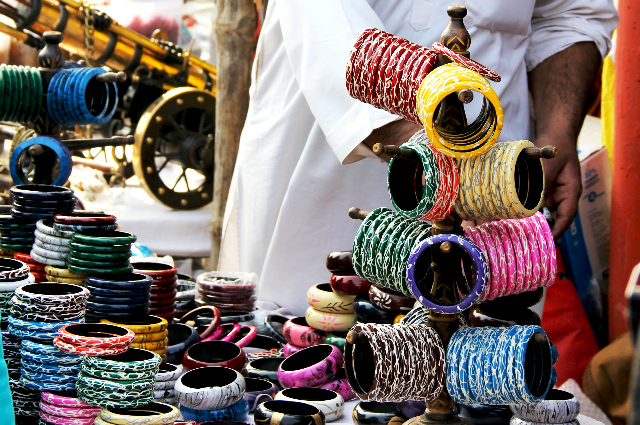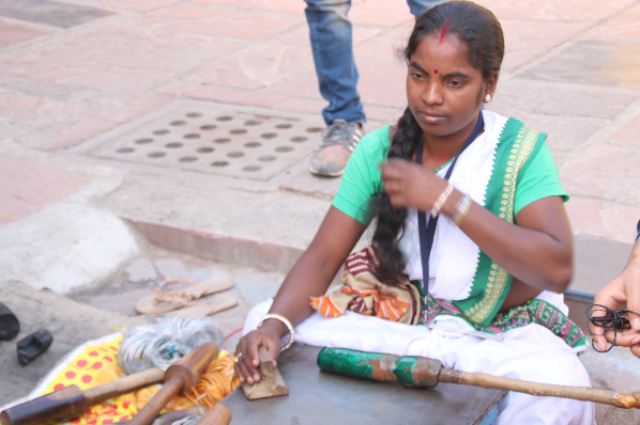
Source: Nishta Sharma on Unsplash
My family and I visited Jaipur when I was a little girl. I watched spellbound as I saw lac bangles and toys being made. The process was mesmerising. Several different colours formed a swirling pattern under the effect of the heat. Then the toys were set aside to cool down before being handed over to us children. I found out later that the lac that I saw had a long journey: starting from the lac insects and ending with dainty bangles.
The Source of Lac:
The Indian lac insect is known as Laccifer lacca. It grows on trees like palash, ber, kusum, etc. It secretes a resin which coats the branches of these trees. Sometimes these coatings can be up to 3 cm thickness or more. These branches are broken off, the lac is melted in mud kilns and purified by washing and by several other processes. The natural resin is reddish in colour. In India, Bihar, Jharkhand and Chhattisgarh are the states commonly supplying lac to the rest of the country. India is the largest producer and the largest exporter of lac in the world.
After purification, some additives are added to this natural lac. Colouring agents, titanium and wax are the common additives. The percentage of lac in the final product is a measure of its quality.
Bangle making:

Since lac itself is brittle, it needs a firm material to form a frame so that the desired shapes can be achieved and maintained. Lac bangles usually use brass or steel frames. The lac is heated, colour is applied to it and it is cut into strips which can be laid onto the metal frame. After firmly fixing it on its frame the bangles are set aside to cool. This part of bangle-making is usually done by the menfolk.
Usually, lac bangles are decorated with small beads, mirrors, pearls, etc. This process is labour-intensive as each piece of embellishment has to be individually pasted onto the bangle meticulously. This process is called Chipai. It is careful and artistic work and is usually done by female artisans.
Lac is a versatile material for bangles since it can be made in various colours and can be decorated in myriad ways. Lac bangles can be made in many styles. The simpler ones can be for daily use. And the heavily embellished ones can be part of bridal wear. In some places in Rajasthan, there is an option of even getting bangles made to order and according to the customer’s specifications.
Lac jewellery also extends beyond bangles and includes rings, earrings and necklaces. Though this jewellery is most popular in Rajasthan and Bihar, it has a nationwide demand. Though beautiful, lac jewellery is brittle and is sensitive to heat. It breaks and gets deformed in very hot weather. The same heat sensitivity that makes it breakable also endows lac bangles with an advantage. If cracked, they can be repaired quite easily and multiple times. The lac is melted and the damage is set right.
Lac Art in India: The Locations
The state of Rajasthan is famous for this art. One of the oldest homes of this art is in Maniharon ka Rasta in Jaipur. The place is bustling with bangle-sellers and keen shoppers. You will also see the artisans working on their stoves and furnaces. The selling of bangles is often also in the hands of the womenfolk from the artisan’s family. This place is a treat for the senses with its colours and its energy.
It is said that lac craftsmen were brought to Jaipur from Uttar Pradesh by Maharaja Jai Singh of Jaipur. Lakhera and Manihar clans are the artists traditionally involved in the art of making lac jewellery in Rajasthan.
Though Rajasthan is commonly associated with lac work, the craft is practised in several parts of the country in various forms. In Orissa lac is used to make combs, pens and other objects. In Surat and Ahmedabad lac is used to make bangles and toys. In Bengal, jewellery and other knick-knacks are made from lac. Karnataka and Andhra Pradesh also have their lac handicrafts.
There are sometimes regional variations in the manufacture of lac objects. In Hyderabad, the best place to buy lac jewellery is Lad Bazaar. Here, the process of making bangles involves the use of a clay pot (Kumpeti).
Lac Art as Part of the Tradition:
These bangles are part of the local tradition and different coloured bangles are used for different occasions. Red bangles are traditionally worn in marriages and pink bangles are worn during the festival of Holi. In addition, lac bangles are worn on Teej and Karwa Chauth.
An Uncertain Future:
This unique art form is facing several hurdles. Deforestation has made lac farming difficult. Very hot summers and dry rainy seasons decrease the production of lac from the existing trees. This has led to a rise in the cost of lac. Added to this is the cost of buying lac from private traders and middlemen (instead of the farmers themselves). This makes it increasingly difficult for the artisans to afford the raw material for their craft. There is competition faced from substitute materials which are passed off as genuine lac and are cheaper.
In some places, like Hyderabad, retailers provide raw materials to artisans, who usually work from their homes. However, the profits made by the sale of jewellery don’t always make their way to the artisans. In addition, business was adversely affected by the COVID-19 lockdown.
In Rajasthan, artisans are encouraging their children to get an education and move out of the family business. In Hyderabad, some workers are opting to work as construction workers rather than continue with the making of lac jewellery.
The process by which the secretions of an insect are converted into objects of beauty is a mark of human ingenuity. Wide knowledge of this awe-inspiring art and the hard work that goes into it will help us consumers understand the true value of this art. This exquisite Indian art form also needs support from the government so that centuries of traditional knowledge is not lost forever.
